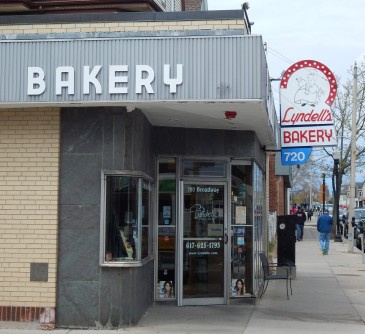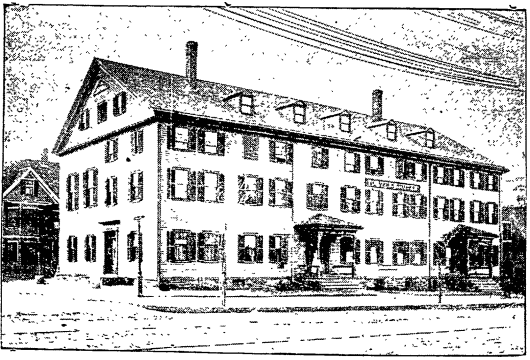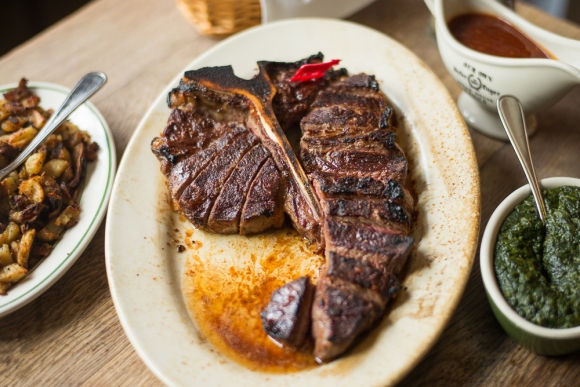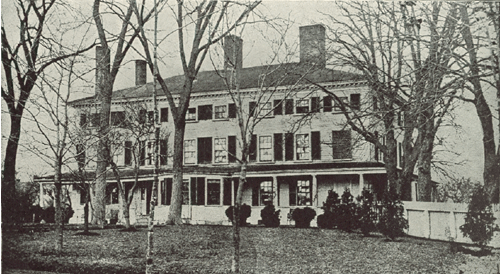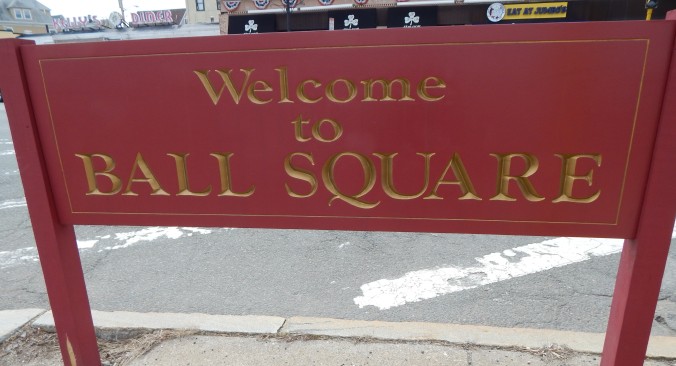Part 1: The Life of Silas Holland
In Part 1, I wrote about the life of Silas Holland, for whom Holland St. in Somerville is named. Part 2 describes the unexpected death of Silas’ grandson Holland Bennett. While on vacation in Italy, Holland disappeared without explanation. He was never heard from again and his body was never found. The story became international news, appearing on the front page of papers around the world. Several explanations were posited, one eventually became conventionally true. The whole story, however, can never be known.

Front page headline from The New York Times, June 12th, 1909
In May of 1909, Holland Bennett, a twenty-seven-year-old lawyer, wed Lucetta Averill Upham. Both bride and groom came from well-to-do Cantabrigian families – Holland’s father was President of the Cambridge Electric Light Company and Fresh Pond Ice Company while Lucetta’s was City Auditor. Holland and his bride had known each other since a young age, growing up together on Linnaean St. in the Avon Hill neighborhood. Both families were part of a closely knit community and for many years, the neighborhood children held an annual fundraiser in the Bennetts’ living room for the nearby Avon Home, a charitable organization for children in need. Their relationship continued into college, with both attending school nearby at Harvard and Radcliffe. The couple’s many long ties were well reflected in their wedding, with siblings, childhood friends and others from their university days standing at their sides. The ceremony was presided over by the Reverend Edward S. Drown (ironic, given Holland’s eventual fate) and was described in The Boston Globe as “one of the most brilliant of the season.” To celebrate their nuptials, the couple planned a three-month European voyage, it would be their only trip together as husband and wife.
After their wedding, the Bennetts set sail for Italy. In Naples, the newlyweds stayed at the brand new Hotel Excelsior. Constructed the year before, the fashionable Belle Epoque hotel boasted crystal chandeliers, elegant marble floors and a prime location overlooking the gulf. Holland and his wife took short trips to nearby Pompei, Sorrento and Capri. While aboard the ferry to Capri, the Bennetts made the acquaintance of William Sallmon, a Yale professor on his way home from China. He would later recount the saga to the press in New York, who incorrectly recorded his name as “Sallman.” Enjoying each other’s company, the trio drove together to Anacapri at the island’s center where they parted ways. By coincidence, Holland, Lucetta and Prof. Sallmon were reunited in the galleries of the Vatican in Rome. That evening, Holland shared with Sallmon that their restful Mediterranean honeymoon was intended to have medicinal effects. Some years before their wedding, Holland had developed a stomach ailment serious enough to require multiple surgeries. It was hoped that a break from the stress of school and career would spur a recovery. In Rome, however, Holland seemed to be waning. The next morning, at Sallmon’s suggestion, the Bennetts agreed to cut their original trip short – forgoing their plans in Venice and Switzerland – and instead follow the professor through Florence, Pisa and Genoa to Naples and eventually home across the Atlantic.
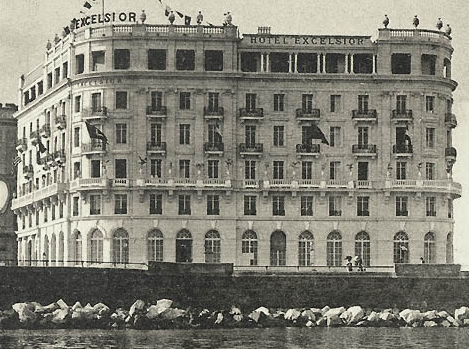
The Hotel Excelsior in Naples, c. 1908
By most accounts, the steamship Berlin left Genoa on the morning of Thursday, June 10th, 1909. The ship, built in 1908, was to stop in Naples before making its first return trip to the United States. Holland and Lucetta met for lunch in the early afternoon and were seen strolling the decks arm in arm. The timeline of what happened next differs depending on the source, but what seems generally agreed upon is that Lucetta accompanied a group of American women to the ship’s saloon while Holland went above deck for a smoke. Sometime that evening, possibly before dinner possibly as late as midnight, Lucetta left the saloon in search of Holland. When she was unable to locate him, she took the news that her husband had gone missing straight to the captain.
Initially, the Berlin’s Captain Langreuter, with his twenty-six years of experience at sea, doubted that a man could jump or fall from the deck unnoticed. He organized a thorough search, examining every cabin and area of the ship from bow to stern and from the uppermost decks down to the cargo hold. Langreuter also retraced the path from Genoa, sweeping the sea’s surface with a searchlight for several miles. He suggested, however, that there would be very little chance of recovering a fully-clothed body at sea. His death unconfirmed in the search, it was thought that Holland may still be alive, disguised aboard the ship, and hoping to escape unnoticed into Naples. Guards and officials scanned the face of every man leaving the Berlin and kept watch over all decks on the chance that Holland snuck away over the side (similar methods of surveillance were employed when the ship next docked at Gibraltar). While no motive for escape was ever put forward, some employees held onto a belief that Holland had jumped ship and swam to the island of Caprera (off the coast of Sardinia, hundreds of miles from Naples). Even assuming the newspapers misreported the island’s name and that the crew actually believed Holland swam to Capri, which the Berlin probably passed in close proximity as it entered the Bay of Naples, it seems highly unlikely that Holland would engineer his honeymoon with an ulterior motive to exchange a comfortable life in America for one of an anonymous Italian vagabond. Given his reported poor health, it also seems unlikely that he was physically capable of making the swim. Lucetta kept faith that a body may be found on the Berlin and when it arrived in New York City it was given a final search.

S. S. Berlin
Captain Langreuter thought Holland was hiding, the police in Naples thought he had been kidnapped. Neapolitan authorities searched buildings near the harbor and the involvement of the Neapolitan Camorra, a centuries-old criminal organization analogous to the Sicilian mafia, was suspected. The Camorra effectively ran Naples with many politicians and public officials firmly in their orbit. Two theories quickly formed. The first was that Camorra associates had snuck their way onto the ship and murdered the wealthy American for any petty cash and jewelry he had on him. Then, it was supposed that the men dumped the body overboard and either swam to shore unnoticed in the night or exited disguised when the ship arrived at port. The second theory, favored by the police, was that Holland was kidnapped by Camorra gangsters and would be returned for a hefty ransom. The Camorra theories may have been attempts to link Holland’s disappearance to another breaking story at the time. That same week, a wave of arrests were made in Ohio. The apprehended were members of the Society of the Banana, a criminal organization with ties to Naples. It was suggested in some places that Holland was murdered in a revenge plot against the United States or kidnapped as a bargaining chip. Holland’s family in Cambridge doubted the validity of these Camorra theories and, after searching the Neapolitan slums and the Berlin without turning up any leads, the police also ruled out gang involvement. In 1911, forty Camorra members were put on trial in Italy. Gennaro Abbatemaggio, a Camorrist turned police informant, became a leading figure of the proceedings and listed several ill deeds allegedly performed by his former cohorts. Among the crimes listed was the robbery and murder of Holland Bennett. Abbatemaggio was said to be unfaltering on the stand, delivering consistent testimonies. Whether his stories came from memory, imagination or were supplied by the prosecution was left somewhat in question. When news of the trial reached Cambridge, the Bennett family reaffirmed their skepticism in the local press.

Members of the Neapolitan Camorra on trial in 1911
If foul play could be ruled out, then it seemed increasingly likely that Holland’s death was a suicide – an answer which satisfied the police but not the man’s widow, nor his family in Cambridge nor many who met him aboard the steamer. It may seem unlikely that a man with Holland’s wealth and prospects would choose to end his life during an idyllic honeymoon along the Tuscan coast. However, the interiors of Holland’s mind are wholly unknown to us and the gleaming surface of his life may have obscured insurmountable anxieties submerged deep below. Many firsthand accounts suggest that Holland’s final days were joyful, with other passengers describing his light-hearted nature. Postcards which arrived home from Rome and Florence depicted a cheerful trip and contained anticipation for the upcoming school year at Harvard. But, other accounts describe a young man in dire health exhibiting increasingly erratic behavior. According to Prof. Sallmon, Holland grew more dejected throughout their time together. In Genoa, he was diagnosed with acute melancholia – characterized by a gloomy, depressive state – and he told his wife he believed his condition to be incurable. Two further anecdotes (which are difficult to place in the timeline and possibly conflict with other descriptions) indicate a harried mental state. Prof. Sallmon related to The Boston Globe that while aboard the Berlin, Holland “attempted to crawl through the porthole of his cabin and after a little while ran from the cabin” while Lucetta reported that Holland “suddenly left her in their cabin and that she had been unable to find him in any of the general rooms or on any of the decks.” Trying to determine a motive, police questioned Lucetta about any fights they may have had that day. Unable to stomach the thought, she broke down and wept, leaving the question unanswered.
Many close to Holland chose to believe his death had been accidental – that he had suffered a seizure while above deck, tumbled over the railing and drown in the sea. Reports from Prof. Sallmon, Lucetta and Holland’s family make this theory seem the most likely. Holland had been dogged by health problems since at least 1906, when he underwent a major surgical stomach operation. His recovery was slow and he developed signs of nervous hysteria and vertigo. While his trip was intended to spur recover, Holland continued to flag in Italy and sought medical advice from an American consul in Pisa. Learning that the nearest sanitarium capable of sufficiently treating him was in Switzerland, Lucetta decided to return Holland to his doctors’ care in the United States. According to Prof. Sallmon’s report to the Boston Evening Transcript, Holland’s health took a sharp turn while on course for Naples. In the early evening, Holland found Sallmon in his cabin and requested accompaniment to the ship’s surgeon. Sallmon needed a minute to gather his belongings and upon emerging could not locate his friend, the implication being that he plummeted to his death in the short time it took Sallmon to get ready. It came to light only afterwards that Holland had suffered a similar attack in Cambridge and had been found unconscious in the street. He kept the information secret from his friends and family, consulting only with a physician. Holland’s father Josiah Quincy Bennett attested that accidental death was the only possible solution in the Cambridge Chronicle and Whitman Bennett threatened legal action against the North German Lloyd company (which operated the steamship) for not taking sufficient measure to monitor his brother’s health.
“My son must have fallen overboard on the night on which his absence was first noticed. He could not have committed suicide, nor could he have been killed or kidnapped by the Black Hand. I have always been thoroughly intimate with my son’s affairs. In them was nothing to cause his to commit suicide. He was abroad on his wedding trip. His affairs had been left in the best of shape; there was nothing on his mind even to worry him. I know he never had any trouble or even in the slightest way came in contact with any Black Hand societies. He never had anything to to do with the arrest of any members of that society in Ohio, as has been intimated, or anywhere else.”
-Josiah Quincy Bennett in the Cambridge Chronicle, June 19th, 1909
None of the reporters covering the story (and there were several – articles appeared on the cover of The New York Times, The Boston Globe and regional papers across the country) seemed to suspect Holland’s wife of murder. However, in the age of Lifetime television, Star Magazine and Gone Girl, it feels impossible not to wonder if this was a honeymoon homicide. Money seems to be the obvious motive here and the Bennett family had considerable wealth. After his death, Lucetta received Holland’s entire estate of $5,000 (comparable to about $750,000 today). This is no small sum, but if money was her only motivator, it does seem like she stood to make a lot more if her husband, a young lawyer, had survived to have a lengthy and successful career. Lucetta, whose parents lived down the street from Holland’s, came from money herself and may not have been too interested in her husband’s wealth. Perhaps even more telling of her innocence is the close relationship she maintained with the Bennett family. The Bennetts and Uphams were united in their grief and Holland’s brother Whitman was with Lucetta’s parents when they met her at the docks in New York City. Upon returning to Cambridge, she moved into what would have been their marital home, around the corner from her parents and in-laws. For several years she continued to be a member of the Avon Club, an organization through which the Bennetts, Uphams and other families in the neighborhood held charitable fundraisers. Six years after the incident, in February 1916, she remarried – to Harry Peabody, an insurance man. After the wedding, still a young woman at 31, she began life with her second husband in Wellesley Hills.
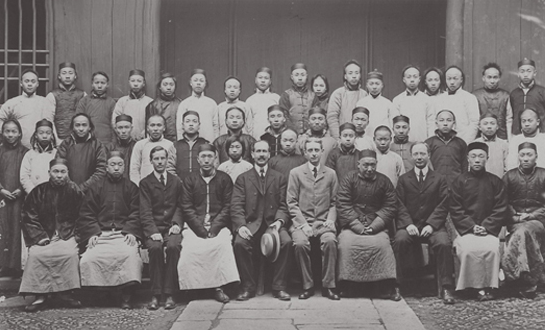
The Yale Foreign Missionary Society in China. Prof. Sallmon is the man holding a hat in the front row.
While researching this article, I grew suspicious of Professor Sallmon, the mysterious stranger who coincidentally enters the story at multiple points. Sallmon’s account informed much of the press coverage and helps establish the severity and urgency of Holland’s illness. It includes private encounters that cannot be confirmed or denied by other parties and places Sallmon and Holland together minutes before the latter’s death. If Sallmon was Holland’s killer, it seems plausible that he could use what he had learned of Holland to fabricate a believable story of accidental death. Truthfully, my theory may be been based on a hundred-year-old typo: the newspapers universally and incorrectly refer to the professor by the name “Sallman.” Finding no evidence of a Yale-affiliated William Sallman, I began to suspect that the man the Bennetts met in Capri was some roguish conman or imposter. In reality, William Sallmon was a benign divinity professor returning home from China, where he had spent a year running the Yale Foreign Missionary Society. Several sources mention his time at both Yale and in Minnesota where he served briefly as President of Carleton College. Years after the incident on the Berlin, Sallmon moved to Chula Vista, Calif. where he became a leading figure in the early days of the state’s avocado industry. Perhaps the erroneous name should not be attributed to the press, but to the man with whom they spoke. Imagine that the real Professor William Sallmon meets a charismatic psychopath enroute to America. That man later adopts Sallmon’s identity, misspelling the name “Sallman”, and meets the Bennetts at Capri. Perhaps spotting an easy mark in the sickly rich man, perhaps jealously obsessed with this happy young couple, perhaps falling delusionally in love with Lucetta, Holland or both, “Sallman” stalks them to Rome. While in Rome, he ingratiates himself to the newlyweds, gains their confidence and convinces them to follow him to Florence, Genoa, Naples and eventually New York. At sea, he finds himself alone with Holland and murders him (as intended or in an escalating confrontation). Before the boat reaches New York, “Sallman” concocts a story and relays it to the reporters. He escapes to adopt a new persona, or to live as “Sallman” without the real professor’s knowledge. The theory is obviously unlikely, however it is not impossible.
None of the theories are entirely impossible. The historic record, based on incomplete testimonies, perceptions and hearsay, fails to construct an exact, accurate account. Instead, it offers a pointillist array of data points and facts from which a likely, agreed upon truth can be discerned. Over time, the hundred years between now and then, the image fades. Fewer sources exist today to shade and color our understanding of the information. When accounts conflict, we are left unable to reconcile the facts and must concede that aspects and angles of this story cannot be defined. Ultimately, only one person could possible know what happened aboard that ship, and even Holland Bennett may have missed out on the full picture of his death as it developed around him.

